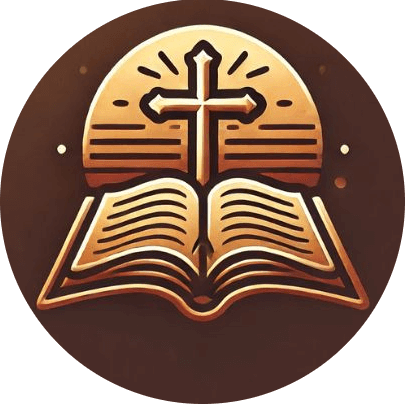Ruth is one of the most significant books in the Old Testament for the Church. It explains like no other book in the Bible, the role and mission of the Kinsman Redeemer. This book is also an essential prerequisite to understanding the Book of Revelation. Before attempting to study Revelation 5, you need to understand the Book of Ruth.
In many respects, Ruth is the ultimate love story. It’s a love story on several levels. It’s a love story because Ruth falls in love with Boaz – that’s the main plotline. But overlaying that is the ultimate love story, a love story written in blood on a wooden cross, erected in Judea more than two thousand years ago.
Chapter 1
Ruth Remains with Naomi
Life was not easy in those days; for during the period of the judges, “Israel had no king so all the people did what was right in their own eyes” (Judges 17:6). How strange that famine should hit Bethlehem, a town whose name means “house of bread,” thereby driving a family to Moab.
Elimelech, (which means “God is my king”) and his wife Naomi (“pleasant”) were forced to move to Moab along with their two sons, Mahlon (“unhealthy”) and Chilion (“puny”). The sons marry, but about ten years later all the men died, leaving Naomi destitute.
During those ten years, things began looking better back in Bethlehem, so Naomi decided to go back home. She released her two daughters-in-law from any obligations to her and encouraged them to find new husbands since they were still young. Naomi urged them not to follow her.
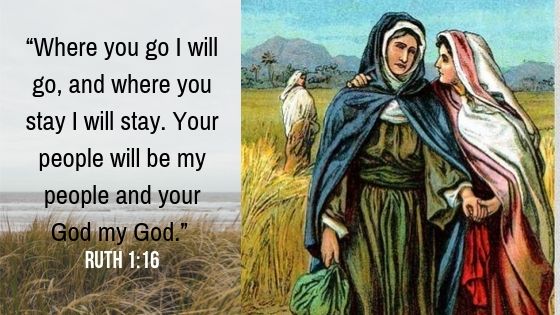
Orpah ultimately decided to stay in Moab but Ruth (which means “desirable”) clung tightly to Naomi. In fact, her commitment is one of the most famous passages in the Bible. Ruth said:
“Entreat me not to leave you, or to turn back from following after you; for wherever you go, I will go; and wherever you lodge, I will lodge; your people shall be my people, and your God, my God. Where you die, I will die, and there will I be buried. The Lord do so to me, and more also, if anything but death parts you and me” (Ruth 1:16-17).
Ruth’s statement is one of the most magnificent confessions found anywhere in Scripture. First, she confessed her love for Naomi and her desire to stay with her mother-in-law even unto death. Then she confessed her faith in the true and living God and her decision to worship Him alone. She forsook her father and mother (Ruth 2:11) in order to cleave to Naomi and the God of her people.
Chapter 2
Ruth Gleans in the Field of Boaz
One of the values of the book is that to understand it, you have to do a little homework about the Law of Gleaning and the Law of the Levirate Marriage. The Law of Gleaning was a form of welfare. If you owned a field, your reapers could go through the field once, and only once. Whatever they missed was left for widows, the destitute, orphans, etc.
The existence of the gleaning law was proof of God’s concern for the poor among His people. The nation was instructed to treat the poor with equity (Exodus 23:3, 6; Leviticus 19:15; Proverbs 22:22-23) and with generosity (Leviticus 19:9-10). God was also concerned for the widows, many of whom were poor, and He told the people to care for them (Exodus 22:22-24; Isaiah 10:1-2).
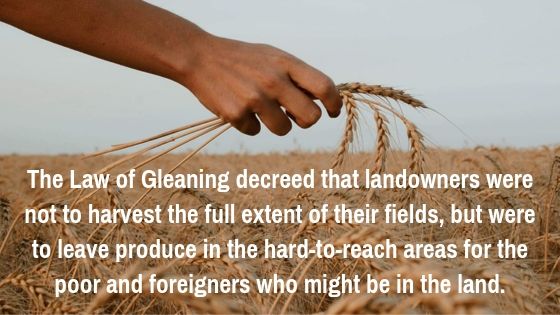
In her gleaning, Ruth happened to come to the part of the field belonging to Boaz (which means, “in him is strength”), one of the wealthiest landowners in the area. He was probably the primary leader among the men at the gate.
Boaz was introduced to Ruth by an unnamed servant. She obviously caught his eye because he instructed his supervisors not to let the young men touch her, and he gave her protection. He also instructed them to drop handfuls of grain on purpose.
It so happened that Boaz was a kinsman for Naomi’s family, which is why this is so important to us. The Law of Redemption said when someone sold their property; they actually sold only the rights to the property, not the title (the title belonged to God).
If you died, a kinsman of your family could go and pay the money to redeem the land. Naomi sold her property ten years before. Now they were back, but since she was destitute and couldn’t buy it back, a kinsman of hers would have the right to purchase that land from whoever was using it (the Law of Redemption is in Leviticus 25).
There is also a Law of the Levirate Marriage. If you were a widow without issue, you could ask your nearest kinsman to raise up an issue with you. He didn’t have to, but if he did, it would continue the line (see Deuteronomy 25). As we shall see, a family redeemer could rescue relatives from poverty and give them a new beginning.
The purpose of these laws was to preserve the name and protect the property of families in Israel. God owned the land and didn’t want it exploited by rich people who would take advantage of poor people and widows.
As a woman, a poor widow, and an alien, Ruth could have no claims on anyone. She was at the lowest rung of the social ladder. But grace is favor bestowed on someone who doesn’t deserve it and can’t earn it. Ruth received grace and the channel of that grace was Boaz.

Ruth’s faith in God’s Word led her to the field of Boaz. The love of Boaz for Ruth compelled him to pour out his grace upon her and meet her every need. Ruth’s experience of grace gave her new hope as she anticipated what her family redeemer would do.
Chapter 3
Ruth at the Threshing Floor
The threshing floor was usually a raised platform outside the village and often on a hill where it could catch the evening breeze. Once the grain was harvested, the workers would throw the grain into the air, and the breeze would carry the chaff away while the grain fell to the floor. The men often worked in the evening when the breeze was up, and they slept on the threshing floor to protect the harvest.
Naomi understood all of this background. When she realized that Ruth happened upon the field of Boaz, she saw an opportunity because Ruth could put the bite on him to solve everybody’s problem. He could get Naomi back the land she had forfeited years ago and give Ruth a new life. So Naomi instructed Ruth on what to do.
Ruth washed herself, put on perfume, and dress in her nicest clothes. Then she went down to the threshing floor where Boaz was sleeping, uncovered his feet and quietly lied down at his feet. When Boaz woke up and realized she was there, Ruth said, “Take your maidservant under your wing, for you are a near kinsman” (Ruth 3:9).
There was no improper behavior implied in this episode; Ruth was asking Boaz to take her as a Levirate bride and put the authority of his house over her. He was flattered because he was much older and because he had learned a lot about her; she had a good reputation. He wanted to do this, but there was a problem: there is a kinsman nearer than him (Ruth 3:12).
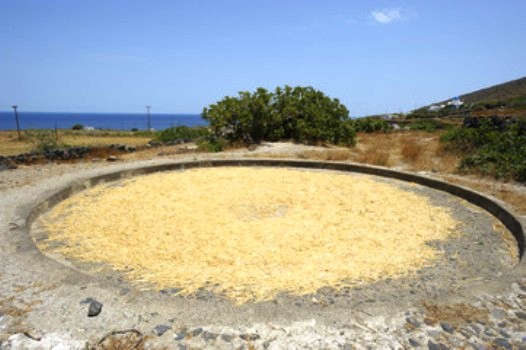
Boaz told Ruth that he’ll see how things will go and gave her six measures of barley to take home as a code to Naomi that he would not rest until the matter was resolved. Not only did he calm Ruth’s fears, but he also made a promise to her concerning their future. That brings us to the climax of chapter 4, the redemption itself.
Chapter 4
Boaz Marries Ruth
The key theme of this chapter is redemption. The words “redeem,” “buy,” and “purchase” are used at least fifteen times and they mean “to set free by paying a price.”
In the case of Ruth and Naomi, Elimelech’s property had either been sold or was under some kind of mortgage. This explains why Ruth was also involved in the transaction.
As a near relative, Boaz could redeem the family property that Elimelech had mortgaged when he took his family to Moab. Naomi wasn’t wealthy enough to redeem it, but Boaz could buy it back and keep it in the family. The wife of the deceased went with the property; therefore, the family redeemer had to marry her and bring her up children bearing the name of the deceased. They would then inherit the property, and the family name and family possessions would continue to be theirs.
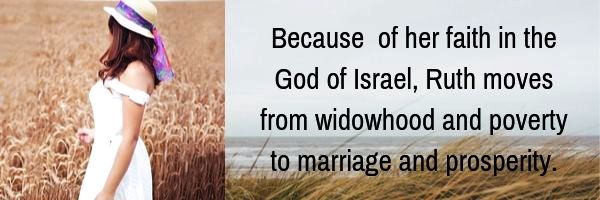
Boaz was at the gate, which is like the city council, and told the nearer kinsman that Naomi had a piece of land t sell and needed a redeemer. The nearer kinsman said that it was no problem. But Boaz said, “By the way, the man who does this also has to take Ruth to bride.” But the nearer kinsman replied, “I can’t do that; it’ll ruin my inheritance.”
The nearer kinsman took off one shoe and gave it to Boaz, a symbol of him yielding the opportunity of the obligation. So Boaz purchased the land for Naomi and purchased Ruth as his bride. And that’s the term he used: he “purchased a bride.”
A Kinsman Redeemer
Looking at the Book of Ruth from the perspective of a goel, a kinsman redeemer, there are four requirements: 1) he has to be a kinsman; 2) he must be able to perform; 3) he must be willing, and 4) he must assume all of the obligations.
God has a goel for you and me. He has to be a kinsman of Adam. He must be able to perform. Revelation 5 is about the Seventh Sealed Book, the Title Deed of the Earth. No man was found to claim that Deed. It had to be a man. John sobbed convulsively because no man was found to redeem the earth.
But wait! There is one who has prevailed to open the book and loose the seals thereof. “Do not weep. Behold, the Lion of the tribe of Judah, the Root of David, has prevailed to open the scroll and to lose its seven seals” (Revelation 5:5).
And that unfolds in the story of Ruth. It has to be a kinsman, he has to be able; he was to be willing; he must assume all the obligations; and indeed, He has. “He proclaimed, “It is finished” (John 19:30)!
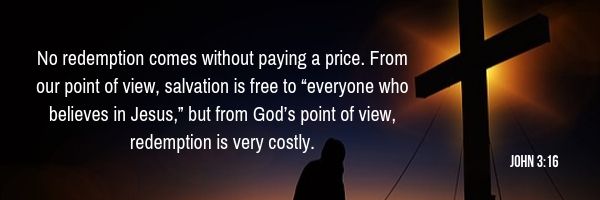
An Ultimate Purchase
Redemption, of which the story of Ruth and Boaz is a vivid illustration, becomes a theme in the New Testament. The primary Greek word used to convey this idea is a commercial word that simply means “to acquire something in the marketplace” (see its commercial use in Matthew 13:44 and Luke 9:13).
But used in reference to Christ and salvation, the word takes on a very important theological meaning. Paul modified this word in Galatians 3:13 and 4:5 with a preposition, so that the term literally means “to buy something and take it out of the marketplace.”
In essence, Paul was saying that by His death on the Cross, Jesus had purchased our pardon. We were under the curse of the Law, enslaved to sin, and destined to eternal death. But Christ redeemed us. He paid the price to buy us out of our sorry state and sad condition.
Read here: What is the Cost of Our Redemption?
John Hagee said, “If you happen to be old enough to recall trading stamps, you may remember that it seemed to take forever to save the thirty or thirty-five books of stamps needed to purchase a toaster or a croquet set. The cost was high. The wait was agonizing. The taste from licking all those stamps was awful.”
The good news is, redemption in Christ is nothing like that. You don’t have to wait. It can be yours today. And the best of all it’s free because Jesus has already paid the full purchase price with His shed blood on the cross.
Conclusion
Ruth is a cameo story of love , devotion and redemption set in the black context of the days of the judges. It is the story of a Moabite woman who forsakes her pagan heritage in order to cling to the people of Israel and to the God of Israel. Because of her faithfulness in a time of national faithlessness, God rewards her by giving her a new husband (Boaz), a son (Obed), and a privileged position in the lineage of David and Christ (she is the great grandmother of David).
The book of Ruth is also a harvest story about the Lord of the harvest bringing in the sheaves. Now, Boaz is the Lord of the harvest and he is also the kinsman-redeemer. So Boaz is a type of foreshadowing of Jesus Christ. Naomi typifies Israel. She was out of the land; through his redemption, she was brought back into the land. Ruth was the Gentile bride, a type of the Church.
In order for Ruth to be joined to Naomi, Naomi had to be exiled from her land. The nearer kinsman couldn’t take Ruth; it was against the law for an Israelite to marry Moabite. But what the law could not do, grace did.

Incidentally, Ruth did not replace Naomi. They are different; they are distinctive. Israel and the Church are distinctive; different origins, different missions. Ruth learned the laws of Israel through Naomi, a Jew. We Gentiles learn the ways of God by understanding the Jewish Scriptures. We worship a Jewish King in a Church composed of Jewish leaders using a Jewish Bible as our authority.
In the threshing floor scene, no matter how much Boaz loved Ruth, he had to respond to her move. And Boaz took it upon himself to be her advocate; he was her intercessor. He confronted the nearer kinsman.
You and I are also beneficiaries of a similar love story that was written in blood on a wooden cross erected in Judea almost two thousand years ago. Have you asked your Redeemer to be your God?
References:
- Learn the Bible in 24 Hours by Chuck Missler
- NIV Cultural Backgrounds Study Bible
- The Transformation Study Bible (General Editor: Dr. Warren W. Wiersbe)
- The NKJV Prophecy Study Bible (General Editor: John Hagee)
Disclaimer: As an Amazon Associate, I may earn a commission when you use any links on this page to make a purchase, but at no additional cost to you.
